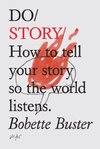
Saved by Rufaro Ruze and
Do Story: How to tell your story so the world listens (Do Books Book 5)

Saved by Rufaro Ruze and
1.Tell your story as if you’re telling it to a friend: this applies no matter where you are or who your audience is.
Exercise 1 Tell us something about yourself we wouldn’t otherwise know. Remember: humility and humour go a long, long way. Yes, you’re the centre of attention. But you have to forget about that. Surrender your ego. This is a great gesture on your part: to reveal yourself to others, in a way that explains who you are, and yet also gives them an
... See more3.Action! Use active verbs or, as I like to say, ‘Think Hemingway’: spice up your verb choices but keep them succinct. Invest in a thesaurus (or a free app). Avoid multisyllabic, erudite, four-dollar words, over-intellectualising, philosophising, qualifying. See how many I just used? It’s boring to keep reading them, isn’t it?
10.Let go: hand over your story, letting it build to its natural, emotional punchline, then end it and get out fast. Leave the audience wanting more. Less is more.
Naturally, I encouraged DJ to try to tell this story – because in the specific story, you tell the universal. Sure, she would risk breaking down for a moment, but I assured her that we should never forget that our audience longs to be moved. We all long to connect. That is all.
5.Gleaming detail: choose one ordinary moment or object that becomes a ‘gleaming detail’. Something that best captures and embodies the essence of the story. Make the ordinary extraordinary.
The first is to consider where you were when a major event occurred. More importantly, try to focus on exactly what you were doing when you understood what was happening. When you do this exercise, think about your ‘hook’ or ‘lead’ that sets up the story with a modicum of context. We need just enough information to explain that this story is
... See moreApparently, the more a child knows his family’s ‘story’ – in other words, the better informed he is about his wider family and obstacles they have overcome in order to survive and thrive – the ‘stronger a child’s sense of control over his life, the higher his self-esteem’.
8.Tune in to your sense memory: choose the strongest of the five senses in your story and use it to make a deeper connection with your audience. There is always one primary sense that dominates every memory.